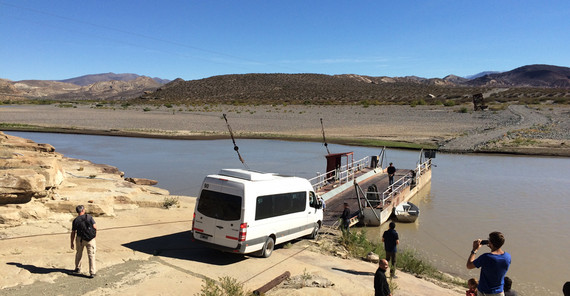We continue southwards within the fold-and-thrust belt of the Neuquén Basin. We find a striking layer of gypsum within the “Huitrin” Formation of the Upper Cretaceous. The gypsum layer witnesses a very isolated phase in the history of the basin, in which there was no connection to the Pacific Ocean. The basin completely dried out and precipitated so-called evaporites in the form of gypsum.
The circumnavigation of the "Cerro Rayoso" reveals a spectacular folding structure, superimposed by younger undeformed reddish sediments of the "Neuquén group". For this particular situation, geologists use the term: angular unconformity. An angular unconformity is an important feature to set deformation phases into a more accurate time frame in the earth history. In this case, we can say that the earliest phase of the Andean deformation must have taken place in the Upper Cretaceous.
We reach the Neuquén River, which we cross with a primitive and hand-driven ferry. This is our last "safe" opportunity to pass the river in that manner.
In the afternoon we find outcrops of the “Agrio” Formation, the lower part of the Upper Cretaceous in the Neuquén Basin. Here, fossils are a real eye catcher. We find complete bivalves and oysters and fragments of ammonites, corals, and many other marine shellfishes from that time in Earth history.
In Zapala we turn eastwards. The deformation style changes and becomes more gently, more open and wider. Long-wavelength crests and creeks along the road show that we left the fold-and-thrust belt behind us and are now within the platform of the basin. We reach Cultral Có, where we will spend the next two days.
Text: Henry Wichura
Published online by: Agnetha Lang
Contact for the online editorial office: onlineredaktionuuni-potsdampde
Prior journal entry
Next journal entry
Show all journal entries

